A reliable service provider with a variety of personalised options. They are vital in making car ownership easy and accessible by providing services like easy loans and professional assistance.We Can Meet Your Requirements.
What TD Auto Finance Has to Offer
Interest Rates That Are Hard to Beat
Find out what makes TD Auto Finance special by learning about our low interest rates and how they can help you finance a car. Learn about the advantages right now!
Versatile Payment Plans
Learn about the many customisable repayment plans offered by TD Auto Finance. Learn how these options can fit into your budget and make managing your auto loan easier and more comfortable, whether you prefer bi-weekly payments or extended periods.
Superior Support for Clients
Discover the secret of TD Auto Finance’s success: their unmatched dedication to satisfying customers. Find out how they put your pleasure first throughout your vehicle financing journey, from helpful representatives to quick support. Relax knowing that assistance is close at hand whenever you require it.
A Guide to the Online Application Process at TD Auto Finance.
Find out more about the easy and convenient online
application procedure offered by TD Auto Finance. Find out how simple the application process is, with no need to leave your house, with only a few simple steps and fast approvals. Get behind the wheel with no stress by starting your auto financing process online today.
Things Needed
Get familiar with the application materials required by TD Auto Finance. Get to know the simple criteria that will guarantee a quick and painless approval procedure. Find out how getting all of your paperwork in order will help your application for TD Auto Finance go more smoothly, from proof of identity to proof of income.
Timeline for Approval
Find out more about the quick and easy approval procedure at TD Auto Finance. Find out how fast applications are handled so you can get a decision on your auto loan in a timely manner. Learn the financing process from start to finish and see how TD Auto Finance works to save you time and effort.
Advice for TD Auto Finance Customers
Establish a spending limit, my dear!
First and foremost in financial planning is the establishment of a budget. To set a reasonable spending limit, first total up all of your income and outgoings. Make sure you’re financially stable by being clear about your priorities and allocating finances appropriately. To keep moving forward with your financial goals, examine your budget on a regular basis and make adjustments as needed.
Pay on time, every time
Certainly! The key to a good credit score and solid financial reputation is paying bills on time. Avoid late penalties and interest costs by setting reminders or automating payments. Make sure you always pay your bills and loans on time by prioritising them. You may boost your credit score, alleviate financial stress, and get closer to your long-term financial goals by doing this.
Get in touch with TD Auto Finance if you’re having money problems.
Keep lines of communication open with TD Auto Finance if you’re going through a tough financial time. In order to talk about workable alternatives, such payment plans or loan modifications, get in touch with them right away. You can avoid payment default and the subsequent score by taking proactive measures to address your issue. In order to financially, TD Auto Finance places a premium on customer connections and provide individualised solutions.
Evaluations by Previous Customers
Constructive criticism
For both professional and personal development, constructive criticism is essential. It raises spirits and rewards appropriate actions. Give sincere and immediate recognition for particular accomplishments or efforts. By doing so, we create an atmosphere that is conducive to growth and development. Offering positive feedback fosters motivation and develops friendships, making for a happier and more productive climate in personal relationships and at business alike.
Potential problem areas
In order to advance in one’s career or one’s personal life, it is crucial to recognise where one may be better. Evaluate the difficulties encountered or comments made in order to identify particular areas that require improvement. Make a plan and then look for ways to improve, like getting a mentor or taking a class. Adopting a growth mindset increases flexibility and fortitude, which in turn boosts performance and happiness in one’s career and personal life.
Total contentment
The sum of one’s experiences and expectations is what makes one happy in the end. Product, service, or relationship-based happiness is all part of it. To ensure positive results, it is important to regularly evaluate and convey satisfaction levels. Resolve issues quickly and ask for helpful criticism to make customers happier. The key to lasting success and mutual benefit is creating an environment where people are happy and fulfilled in their work and relationships.
Overview
synopsis of TD Auto Finance.
A description of the services.
An overview of the TD Bank vehicle lending programme.
Describe TD Auto Finance.
TD Auto Finance definition and explanation.
A summary of the different kinds of auto loans..
Advantages of getting an auto loan from TD Auto Finance.
TD Bank able to provide an auto loan?
The prerequisites for qualifying .
The TD Bank vehicle loan application process.
Things to think about while selecting TD Bank for vehicle financing.
Conclusion
TD Auto Finance offers competitive rates, flexible payment plans and exceptional customer service to ensure you have the best auto financing options. Check out our hassle-free loans and expert advice tailored to your needs to make car ownership easy.

 Cart is empty
Cart is empty 




